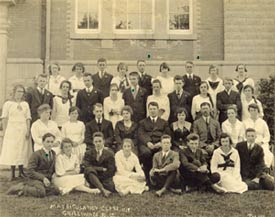
One solution that did occur in the local area was tied to a national initiative introduced, in 1918, and known as Soldiers of the Soil. The program actively sought out volunteer male youth for work on Canadian farms to assist farmers in achieving greater wartime production of foodstuffs. On October 14, 1918, the 61 boys that had been employed by local farmers gathered together, with parents and friends, at City Hall to be presented with their badges; a distinctive lapel insignia. Reverend G.A. Reynolds chaired the meeting and presentation. Mr. F.B. Stacey, M.P. presented the badges and a speech, as did Principal P.H. Sheffield and Reverend G.H. McGill of the Baptist Church, Kitsilano, Vancouver. Although the Food Board organized the SOS program, it was probably administered by the Canadian Standard Efficiency Training for Boys Program, a topic that was the focus of Reverend McGill's presentation. McGill also spoke that it was with regret that the boys and girls, that were not part of the SOS program, but had been engaged in the berry fields and orchards during the summer of 1918 had not been similarly honoured.
The Canadian Standard Efficiency Training [or Tests] program for boys was developed in response to the wartime emergency. The youth under the program were taught that they would have to assume the responsibility of leadership roles in community due to the permanent loss of Canadian young men overseas. The program incorporated education, physical, religious and service development towards attaining its goals.
The boys were paid between $15.00 to $40.00 per month and the differences in pay scale were not reported upon in terms of what was done for higher pay. Most of the boys were from the Chilliwack District but it was further reported that the employment of city boys, locally, had resulted in the city lads favorably changing their view on farm work as an occupation.
The presentation ceremony was reported in the Chilliwack Progress for October 24, 1918:
"In recognition of having 'stayed with the job' until the finish the 61 boys who undertook to do a man's work on the farms of the Chilliwack valley during the season now ending, under the well known 'Sons [sic'
of the Soil' movement, were on Tuesday night last week, presented with badges of service. While the boys, of course, have received their wages, and in many cases, good wages, for the duties they performed during the summer, yet these badges are something more, something that each boy can keep as a tangible recognition of having stepped into the breach caused in the ranks of agricultural workers by the army's demand on the man power of the country." Some 22,385 boys were enrolled in SOS across Canada, of which 20,431 were assigned to farms, 1800 of these youths worked in British Columbia.

Group portrait of the matriculation class of 1919. Group includes young men wearing Soldiers of the Soil lapel pins identified by small green dots. P. Coll 42, file 12.